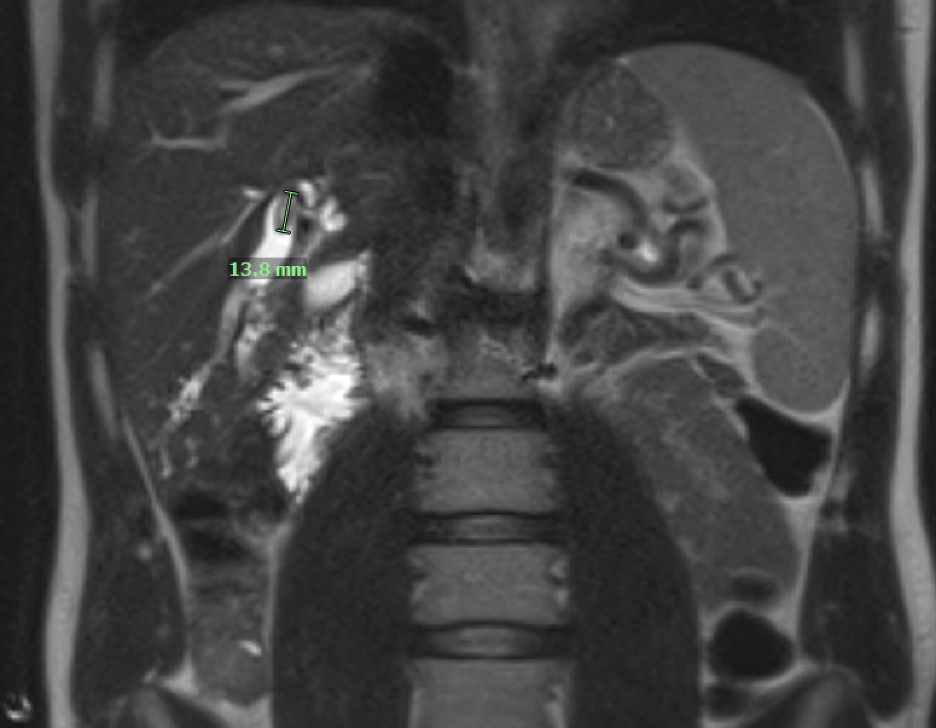Tuesday Poster Session
Category: Biliary/Pancreas
P4387 - Right-Sided Recurrent Pyogenic Cholangitis: An Unusual Presentation of a Traditionally Endemic Disease
Tuesday, October 28, 2025
10:30 AM - 4:00 PM PDT
Location: Exhibit Hall

Mariela Trejo, MD (she/her/hers)
NYU Grossman School of Medicine
New York, NY
Presenting Author(s)
Mariela Trejo, MD1, Simone Jarrett, MD2, Renee Williams, MD, MHPE, FACG1
1NYU Grossman School of Medicine, New York, NY; 2NYU Grossman School of Medicine, Division of Gastroenterology and Hepatology, New York, NY
Introduction: Recurrent pyogenic cholangitis (RPC) is characterized by the formation of intrahepatic and extrahepatic biliary stones that ultimately promote stasis and obstruction. This leads to recurrent episodes of cholangitis. The underlying pathophysiology of stone formation remains unclear, however associations with helminths and chronic malnutrition have been reported. RPC is endemic to Southeast Asia and can affect both hepatic lobes, with left-sided disease being more typical. Here we present a rare case of new onset right-sided RPC in an American male with a history of travel to Asia.
Case Description/
Methods: A 48-year-old Caucasian male with a past medical history of Type 1 diabetes on insulin, GERD, and migraines presented with a one-day history of severe abdominal pain and nausea, without vomiting, changes in bowel habits, or constitutional symptoms. His family history was notable for a paternal uncle with cholangiocarcinoma diagnosed in his 70s. He reported social alcohol use and yearly travel to Singapore. On arrival, he was hemodynamically stable with an exam significant for right upper quadrant abdominal tenderness. Labwork was grossly normal other than a mild neutrophil-predominant leukocytosis. CT revealed severe right-sided intrahepatic biliary dilation without gallbladder inflammation or extrahepatic ductal dilation. MRCP showed multiple intrabiliary stones measuring up to 1.4cm, and distal intrahepatic biliary dilation. ERCP was attempted but unsuccessful due to the acute angulation of the bile duct. He was discharged on oral antibiotics and 3 months later, underwent elective robotic right hepatectomy with cholecystectomy. Pathologic exam of the right liver revealed intrahepatic and extrahepatic stones with acute and chronic cholangitis, as well as focal abscess formation. No background features of primary sclerosing cholangitis, arteriopathic lesions, parasites, or biliary intraepithelial neoplasia were identified. Iron and alpha-1 antitrypsin stains were negative.
Discussion: This case demonstrates that, with a prevalence of less than 2% in the USA, RPC can present not only with isolated right-sided hepatic involvement but also in individuals of non-Asian descent who do not reside in endemic regions. Due to the increased risk of cholangiocarcinoma in this patient population, early diagnosis and treatment of RPC is critical. Further research to understand the underlying pathophysiology of RPC is warranted.

Figure: Dominant intrabiliary stone measuring 1.4 cm proximal to a dilated branching segment.
Disclosures:
Mariela Trejo indicated no relevant financial relationships.
Simone Jarrett indicated no relevant financial relationships.
Renee Williams indicated no relevant financial relationships.
Mariela Trejo, MD1, Simone Jarrett, MD2, Renee Williams, MD, MHPE, FACG1. P4387 - Right-Sided Recurrent Pyogenic Cholangitis: An Unusual Presentation of a Traditionally Endemic Disease, ACG 2025 Annual Scientific Meeting Abstracts. Phoenix, AZ: American College of Gastroenterology.
1NYU Grossman School of Medicine, New York, NY; 2NYU Grossman School of Medicine, Division of Gastroenterology and Hepatology, New York, NY
Introduction: Recurrent pyogenic cholangitis (RPC) is characterized by the formation of intrahepatic and extrahepatic biliary stones that ultimately promote stasis and obstruction. This leads to recurrent episodes of cholangitis. The underlying pathophysiology of stone formation remains unclear, however associations with helminths and chronic malnutrition have been reported. RPC is endemic to Southeast Asia and can affect both hepatic lobes, with left-sided disease being more typical. Here we present a rare case of new onset right-sided RPC in an American male with a history of travel to Asia.
Case Description/
Methods: A 48-year-old Caucasian male with a past medical history of Type 1 diabetes on insulin, GERD, and migraines presented with a one-day history of severe abdominal pain and nausea, without vomiting, changes in bowel habits, or constitutional symptoms. His family history was notable for a paternal uncle with cholangiocarcinoma diagnosed in his 70s. He reported social alcohol use and yearly travel to Singapore. On arrival, he was hemodynamically stable with an exam significant for right upper quadrant abdominal tenderness. Labwork was grossly normal other than a mild neutrophil-predominant leukocytosis. CT revealed severe right-sided intrahepatic biliary dilation without gallbladder inflammation or extrahepatic ductal dilation. MRCP showed multiple intrabiliary stones measuring up to 1.4cm, and distal intrahepatic biliary dilation. ERCP was attempted but unsuccessful due to the acute angulation of the bile duct. He was discharged on oral antibiotics and 3 months later, underwent elective robotic right hepatectomy with cholecystectomy. Pathologic exam of the right liver revealed intrahepatic and extrahepatic stones with acute and chronic cholangitis, as well as focal abscess formation. No background features of primary sclerosing cholangitis, arteriopathic lesions, parasites, or biliary intraepithelial neoplasia were identified. Iron and alpha-1 antitrypsin stains were negative.
Discussion: This case demonstrates that, with a prevalence of less than 2% in the USA, RPC can present not only with isolated right-sided hepatic involvement but also in individuals of non-Asian descent who do not reside in endemic regions. Due to the increased risk of cholangiocarcinoma in this patient population, early diagnosis and treatment of RPC is critical. Further research to understand the underlying pathophysiology of RPC is warranted.

Figure: Dominant intrabiliary stone measuring 1.4 cm proximal to a dilated branching segment.
Disclosures:
Mariela Trejo indicated no relevant financial relationships.
Simone Jarrett indicated no relevant financial relationships.
Renee Williams indicated no relevant financial relationships.
Mariela Trejo, MD1, Simone Jarrett, MD2, Renee Williams, MD, MHPE, FACG1. P4387 - Right-Sided Recurrent Pyogenic Cholangitis: An Unusual Presentation of a Traditionally Endemic Disease, ACG 2025 Annual Scientific Meeting Abstracts. Phoenix, AZ: American College of Gastroenterology.

